The present study aimed at identifying the type of household hazardous waste (HHW) generated, and determining the HHW management practices and their related accident and diseases. One hundredhouseholdsin a residential area in the southern state of Malaysia were randomly sampled. Results showed that the average weight of HHW is 0.025kg/d/hh and 0.4ml/d/hh is the average volume.The common household hazardous product found at home arezonrox bleach, fabric dyes, paints, and medicine bottles. In terms of HHW practices, majority disposed their HHW together with other solid waste. Only a small number of respondents reported to experience skin irritation and poisoning.
Keywords |
| household hazardous, wastemanagement, residential area. |
INTRODUCTION |
| Household hazardous wastes (HHW) constitute a new class of wastes from common household products. Household
hazardous waste are waste generated at the household level that pose a potential hazard to living creatures because they
are toxic or lethal, non-degradable or persistent in nature, and may cause detrimental cumulative effects. Any product
that has a warning, caution, poisonous, toxic, flammable, corrosive, reactive or explosive warning is considered
hazardous (O’Leary & Walsh, 1995). Household generated hazardous waste such as batteries, paints, solvent and
pesticides may threaten human and the environment when improperly disposed even though the amount of hazardous
waste generated by the household products is only a fraction of that generated by the industries (Denr, 1992).
Collectively, such wastes and the hazards posed are a growing concern. |
| Even though the overall impacts of household hazardous waste disposal are not only fully known but potential concerns
include health problems for homeowners, children and pets from improper storage and disposal by the homeowner. For
example, injuries could happen while waste is being emptied, compacted, or transported. Spills and fire hazards at the
collection and disposal sites, and pollution of air, groundwater and surface water are all possible outcomes resulting
from improper disposal of hazardous waste.Due to the danger and risk posed by household hazardous wastes, good
practices of management, handling, and disposal of these wastes should ideally begin in the household (O’Leary &
Walsh, 1995). But to what extent such practices are currently being implemented need to be investigated so that proper
measures could be identified and carried out by the authorities concerned. Hence, the present study was undertaken to
deal with this issue. In particular, it sought to meet the following specific objectives: (a) to identify the type of
household hazardous waste (HHW) generated, and (b) to determine the HHW management practices and their related
accident and diseases. |
| Skudai is a rapidly expanding suburb of Johor Bahru, the largest city in and the capital of the state of Johor in southern
Malaysia. Skudai is part of the new growth corridor of southwest Johor, which includes the Senai International Airport,
TanjungPelepas Port, and the proposed new administrative capital of Johor, Bandar Nusajaya. Its population ranges
between 160,000 and 210,000. It is the headquarters of the Johor Bahru Central Municipal Council and it is home to
one of the public universities in Malaysia. Skudai is located 8 km, 4 km and 16 km from Kulai, Senai and Johor
BahruCity, respectively. There are many nearby towns and housing areas, and one of them is Taman Universiti. Taman
Universiti is a self-contained township situated about 20 km from Johor Bahru City with an excellent access through double-carriageway Skudai Highway and Pontian Highway. There are 12,299 residential units in Taman Universiti.The
residential areas are managed by the Johor Central Municipal Council. With regards to waste collection, private
contractors are appointed. At Taman Universiti, residents dispose of their household waste by putting it inside plastic
bags, which will be placed outside their home to be collected by the private contractors. The private contractors collect
the waste every Wednesday and Sunday at any time of the day. |
MATERIALS AND METHODS |
| This study was concerned with obtaining relevant data on municipal solid waste in Taman Universiti, Johor Bahru
catchment. Permits needed to carry out the study were sought through the coordination of Johor officials, government
offices, and agencies. House-to-house interview and survey were conducted to know the actual condition of household
hazardous waste. Out of 12,299 households located in Taman Universiti. To select the appropriate sample size, Slovin’s
formula was employed. Based on the formula, 100 respondents should be sampled. To select 100 households and HHW
sample, cluster sampling was employed, in which every street where houses were located was considered as a relevant
cluster. Random sampling was then used to determine the street, and hence all houses along the street were selected to
participate. |
| To meet the first objective, a representative container, weighing scale, graduated cylinder and waste plastic bags were
used during actual sampling.From the computed sample size of 100 respondents, generation of HHW was determined
based on weight-volume analysis. The collection of solid waste was conducted every day for 23 days. Wastes were
transported and loaded in a controlled area. Each collected solid waste was placed in a container and the HHW was
segregated from the other components of the solid wastes. Mass of HHW was measured using weighing scale, while
the liquid hazardous waste was poured into a calibrated graduated cylinder for the volume determination. HHW was
computed using weight-volume analysis in which a mean value was determined. The mean is defined as the arithmetic
average of the number of the individual measurements. To achieve the second objective, house-to-house survey was
conducted in which questionnaire was used. The questionnaire asked different aspects related to household hazardous
waste handling (e.g., types, separation, storage, home accidents, disposal, etc.). In the determination of the generated
HHW and its management, collected data was tallied and analysed. Graphs, photographs, and tables were used to show
the results. The data collection period lasted for one month, from September to October 2011. |
RESULTS AND DISCUSSION |
| Table 1 presents the type of household hazardous products and their corresponding characteristics. The different types
of products can be categorized into five main categories: (a) automotive products (e.g., gasoline, motor oil, brake fluid,
wiper fluid); (b) home improvement products (e.g., pain (oil-based and latex), caulk, varnish; (c) health and beauty
products (e.g., nail polish, finger nail polish remover); (d) pesticides (e.g., rat poison, flea killer, insecticides); (e)
household cleaners (e.g., furniture polish, oven cleaner, toilet bowl cleaner); and (f) miscellaneous products (e.g., shoe
polish, fabric dye, mercury).Majority of the homeowners (76%) were also found to use automotive products
specifically gasoline because many own personal vehicles like motorcycles and four wheeled transportation. However,
during the actual sampling, no gasoline waste was collected because respondents purchase rather than produce
discarded gasoline. The lowest generated household hazardous products are roofing tar, organic solvents and
ammunitions. But as shown in Table 1, many homeowners use common household products that can be dangerous
when mishandled and can be hazardous when improperly disposed of. |
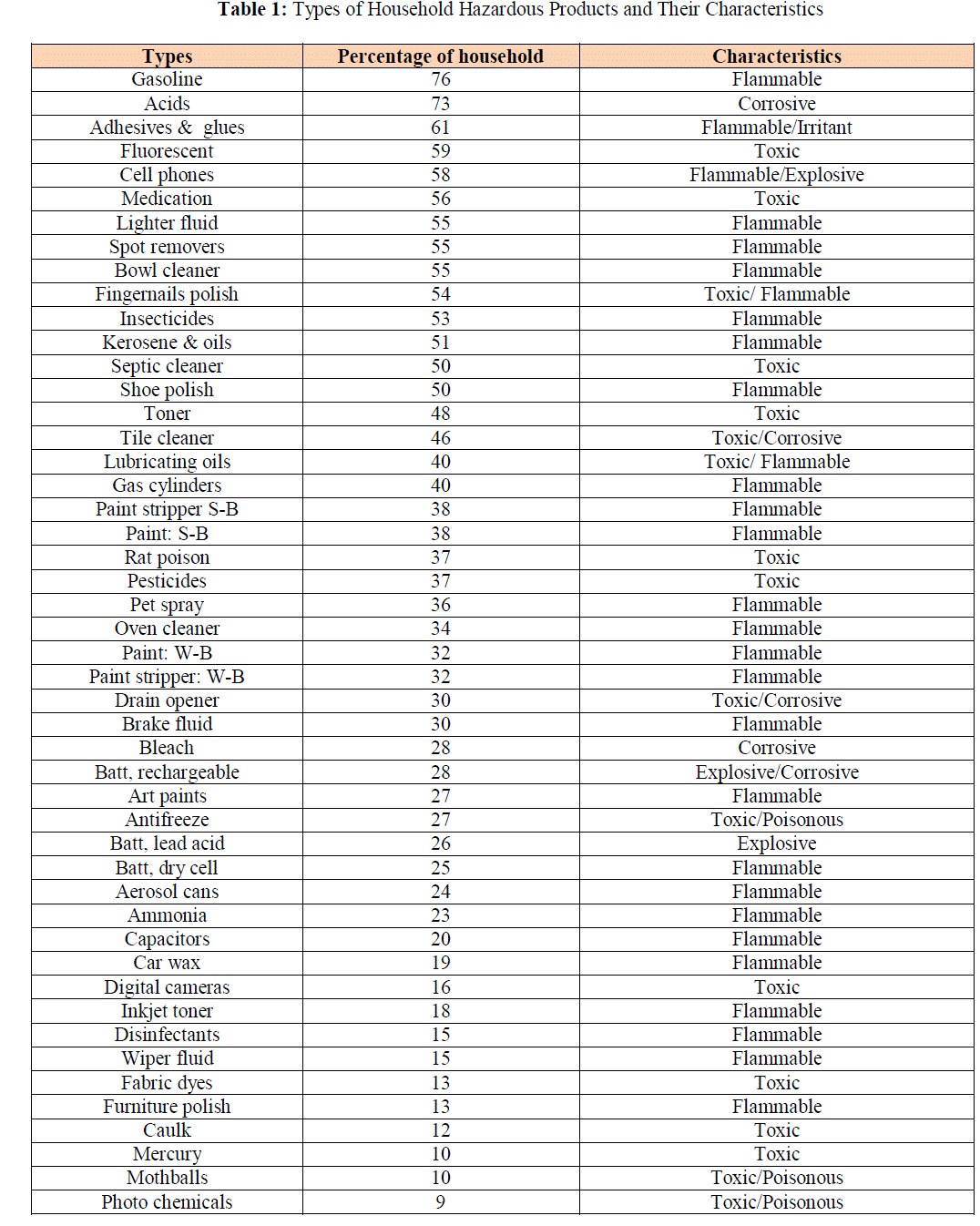 |
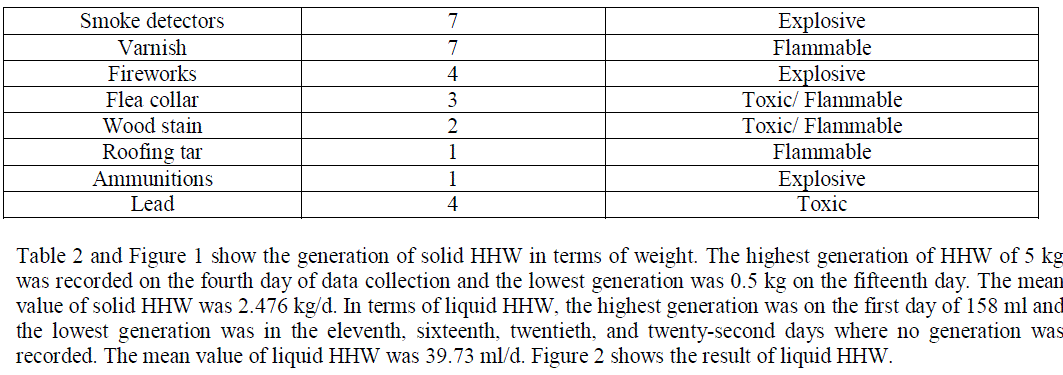 |
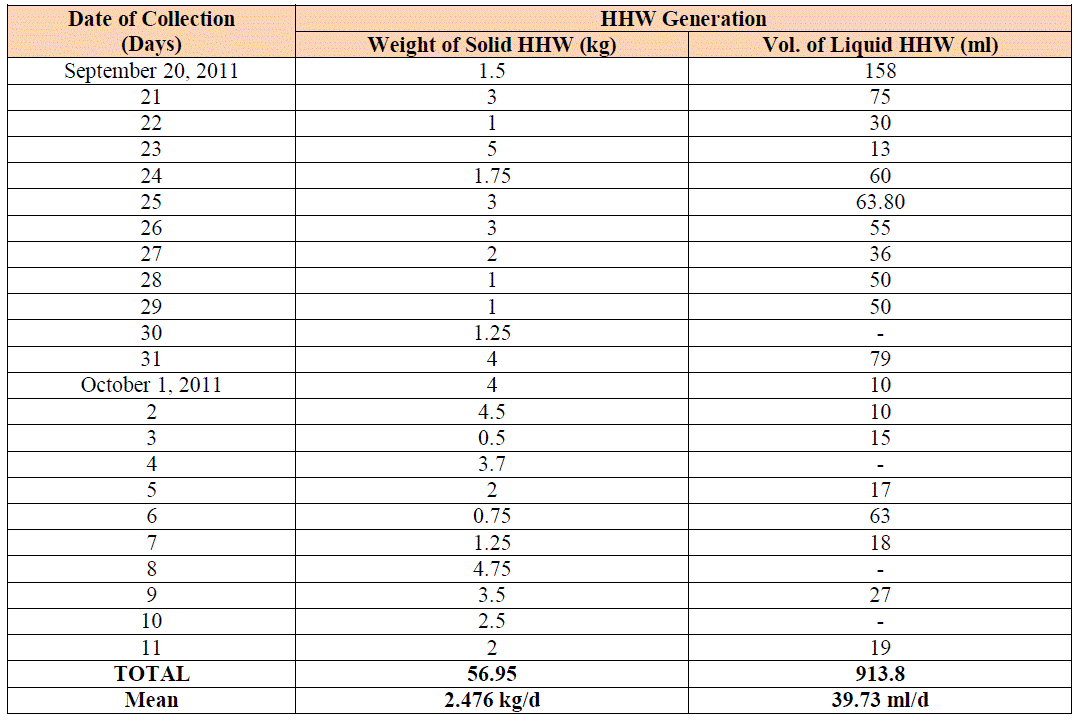 |
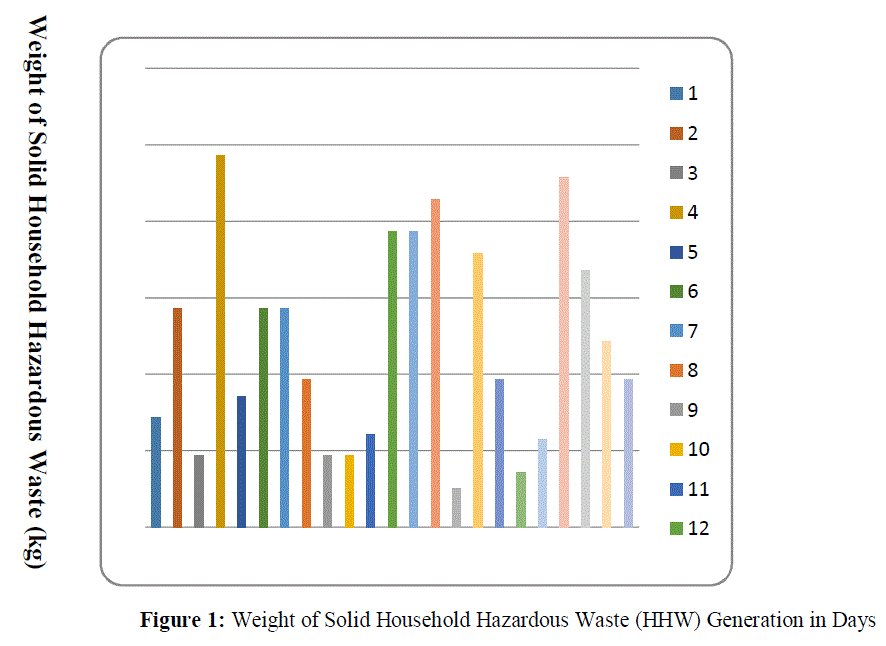 |
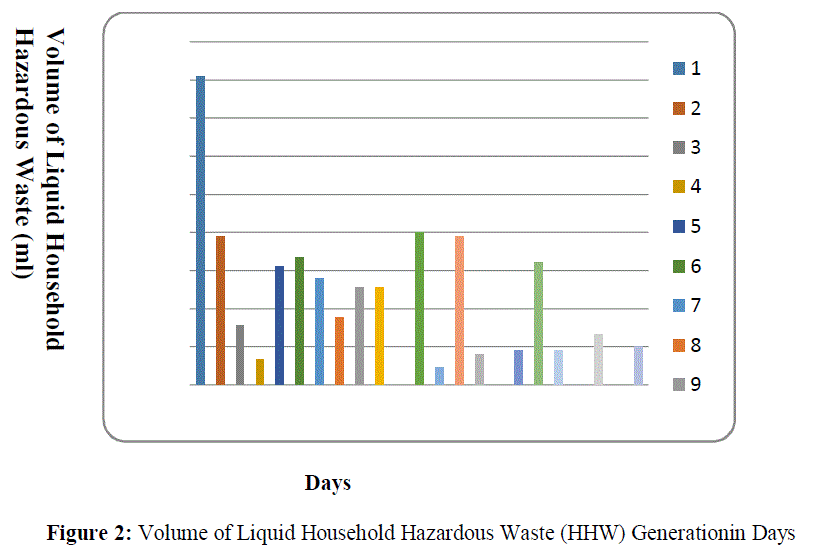 |
| Results also show thatthe total weight of solid HHW generation during 23 days of data collection period was 56.95 kg,
with a total average weight of 0.025 kg/d/hh. For liquid HHW, the total volume generated during the same period was
913.8 ml and the total average HHW volume was 0.4 ml/d/hh.Respondents were asked about whether they follow precautionary measures in handling household hazardous waste. They were informed that precautionary measure was
defined as complying with the instructions given by the manufacturers on how to handle HHW such as making sure
that direct contact with the skin is avoided and handling in such a manner that the environment will not be negatively
affected. It was found that majority of the respondents (78%) reported that they follow the precautionary measures
instructed while the remaining 22% indicated that they do not follow precautionary measuresbecause they are not
concerned with the possible effects of improper handling and disposal of HHW. Respondents were also asked about the
practices they employed in storing household hazardous products. Majority of them (78%) indicated that they have
separate areasfor storing household hazardous product. One-third reported (30%) reported that the common place of
storage is the garageto keep the said product out of reach of children and pets, 21% indicated that they have a specific
area in the cabinet, 18% stored the product in the bathroom, and 9% in the kitchen. The remaining 22% reported that
they have no separate intended area for storing household hazardous product. These wastes are stored anywhere in the
house: some are even mixed up with other nonhazardous products. Figure 3 shows the distribution of the storage
practices amongst studied households. |
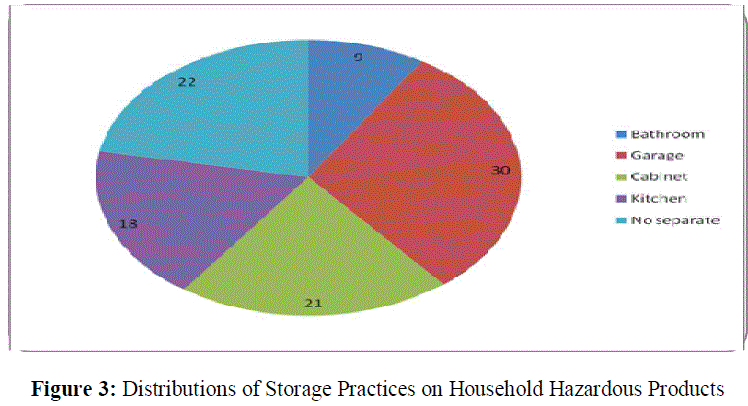 |
| Figure 4 shows that about 68% of the homeowners reported that they dispose their HHW together with other wastes for
the collection by the private contractor because it is the common and practical way of disposing the wastes, followed by
19% who indicated that they burn directly all their wastes because it convenient for them to do so. A small percentage
(10%) reported that they reuse the container for some other purposes while 3% indicated that they bury the wastes
because some wastes explode if burned. |
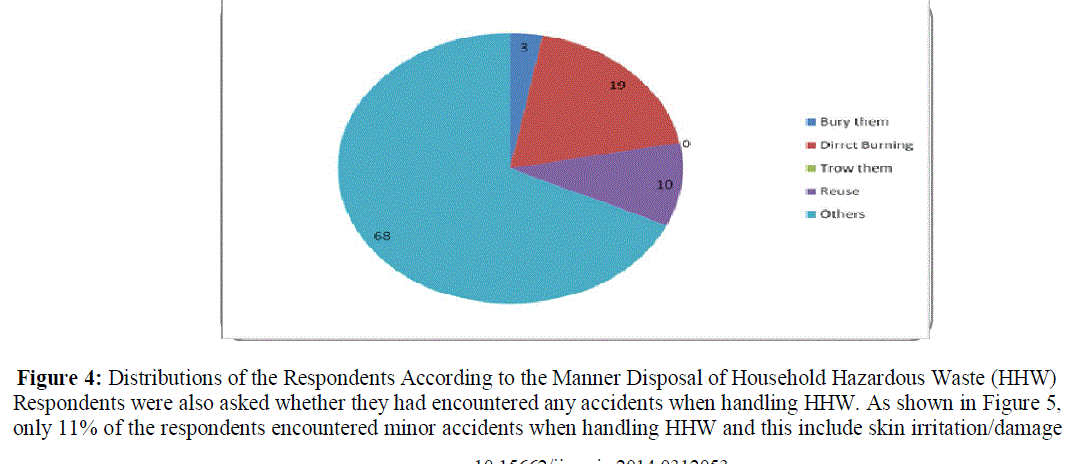 |
| (9%) and poisoning (2%), suggesting that accidents might be encountered due to negligence and improper handling of
HHW. The remaining 89% did not encounter any accidents while handling HHW as they strictly followed the handling
instruction labeled on the container of the household hazardous products. |
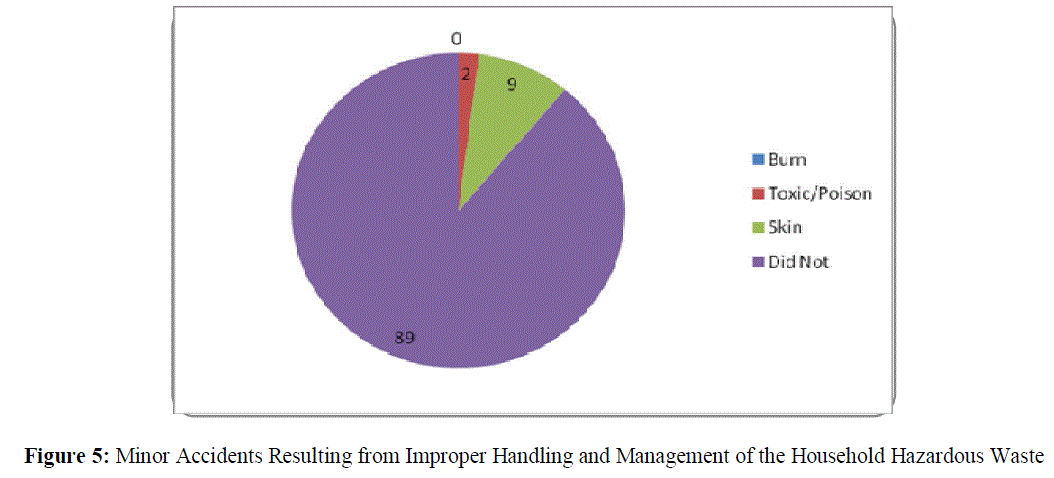 |
CONCLUSION |
| The present study seeks to explore the types of household hazardous waste generated among residents in a residential
area in Malaysia and the HHW management practices and their related accident and diseases. Key findings reported are
as follows: |
| a. The common household hazardous products found at home include automotive products, solvents, medicine
bottles, household cleaners and polishers. Among the automotive products, gasoline (76%) is the most common
products found at home because majority of the homeowner own personal vehicles. The lowest generated
household hazardous product are roofing tar, organic solvents and ammunitions (1%). The types of HHW
collected during the conduct of the study are mostly bleach, fabric dyes, paints and medicine bottles. |
| b. The average solid HHW generation is 0.025 kg/d/hh while 0.4 ml/d/hh for liquid HHW |
| c. Majority 78%) reported that they follow the precautionary measures instructed while the remaining 22%
indicated that they do not follow precautionary measures because they are not concerned with the possible
effects of improper handling and disposal of HHW. |
| d. Majority of them (78%) indicated that they have separate areas for storing household hazardous product. Others
reported the use of garage, cabinet, bathroom, and kitchen as places to store HHW. Some even reported they
have no specific storage area at home. |
| e. Majority (68%) reported that disposing of HHW together with other wastes is a common and practical way of
doing so. Direct burning is also a convenient way to dispose of HHW. |
| f. The common accidents related to HHW are skin irritation/damage (9%) and toxic/poisoning (2%) and the
victims are mostly miners those ages from 7 to 12 years old. |
| Whilst the types of HHW generated by the studied households are somewhat common across many parts of the world
indicated by previous studies (e.g., Guzman & Reyes, 2003; Hammet et al., 2002; Tanaka & Yasuda, 2006), it is the
way the HHW is managed and handled that is eye opening. In fact, the findings of the present study seem to
corroborate the report in the Star Online in 2008 on how Malaysians generally handle their HHW. It was reported that
more than 64.7% end up in the garbage bin, 12.7% are poured down the drain, 2.4% are burnt and 20.2% are disposed
of by other methods like burying or are just arbitrarily dumped (Loh, 2008).Indeed, the current practice of managing
and handling HHW amongst the studied residents indicates the lack of awareness of the dangers and risks involved in
improper disposal and handling of HHW. It also suggests the indifferent attitude the residents have on the effects of their action to the environment or health. This is reflected in the way they dispose of the HHW either by throwing it
away together with other wastes for collection or directly burning them. Lack of awareness amongst households in
handling and managing HHW has been reported elsewhere suggesting that this is one of the common issues in waste
management. Indeed, no amount of measures will be effective without public awareness on the effects of improper
handling and disposing of HHW. The findings of the present study further confirm the existing problem of public
awareness on this issue.Even though the findings may not necessarily reflect the practices of the larger population in
Malaysia, it sheds some light into the problem that the country is still facing in educating the public and creating
awareness on the importance of good waste management. While the country still has a long to go in establishing a good
system of and approach to HHW management in terms of storage, collection, separation, transportation, treatment and
disposal of HHW to protect the health of its citizens and the environment, continuous effort and initiatives in
awareness, training and capacity building program should be implemented.While the present study has provided some
preliminary insight into the current practices of HHW management, further research on the effects of the household
hazardous waste on the environment including the bodies of water and groundwater needs to be conducted. Such
studies are needed so that the general public can be made aware of the danger of their practices to the environment,
were such effects established. |
References |
- K. R. Chowdhury, M. Di Felice, âÃâ¬ÃÅSearch: a routing protocol for mobile cognitive radio ad hoc networks,âÃâ¬Ã Computer Communication Journal, vol. 32, no. 18, pp. 1983-1997, Dec.20
- Denr.âÃâ¬ÃÅimplementation rules and regulation âÃâ¬ÃÅ Department of Environment and Natural Resources ,1992 (PRS 92)
- Hammet W. D, Osmond D. L., &Young,âÃâ¬ÃÅimproving storage and handling of household Hazardous WasteâÃâ¬ÃÂ, north CarlioaoUSA,Wn C. web page :www.soil.nscu.edu(2/8/2007).
- Hammet G. âÃâ¬ÃÅ Houssehold Materials and Hazardous Waste Management (2nded)USA,Wn C. Bwown publisher (2007).
- Guzman, J., & Reyes, J. Loh, J. âÃâ¬ÃÅHazards in household wasteâÃâ¬ÃÂ. The Star Online. Available at: http://thestar.com.my/news/story.asp?sec=greeneveryday&file=/2008/6/8/greeneveryday/18309787(June 8, 2008).
- OâÃâ¬Ãâ¢Leary, Initial & Walsh, Initial. Household Hazardous Materials: A Guide for Citizens. Available online at: http://training.fema.gov/emiweb/is/is55.asp(1995).
- Tanaka, M., & Yasuda, K. âÃâ¬ÃÅReport on hazardous household waste generation âÃâ¬ÃÅin Japan, 24(4), 397-401. (2006).
- MajlisPerbandaran Johor Bahru Tengah, âÃâ¬ÃÅ National Statistics Office Total population, household population and number of householdsâÃâ¬ÃÂ. Malaysia. (2007).
- U.S Environmental Protection Agency (2008). Title of article/web site.Accessed on March 2007, from: www.epa.gov.
- Buenrosto, O., Bocco, G., & Gram, S. Classification of source municipal solid waste in developing countries. Resources, Conservation and Recycling, 32, 29-41. (2001).
|